 Category: Resources
Category: Resources
Preparing for the Harvest – Part II
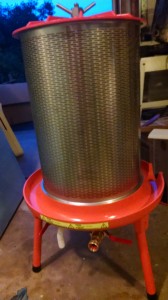
The bladder press is a lovely piece of equipment. below the juice channel, you can see the hook-up for the garden hose.
After three years and more of work and study, we’re close to our first harvest. We started in 2010 with our first classes on viticulture at Piedmont Virginia Community College, and moved on to researching and ordering vines in early 2011. We’ve spent three y ears nursing those vines along, and now some of the varieties – the Viognier especially – are only days away from being ready to pick. (With the rest a bit further behind.) And for all the time we’ve had to think about these things, found myself scrambling in these last few months to make sure I knew what I was doing and had the equipment to do it with.
In some ways, assembling the small items – the yeasts, the beakers, the malolactic bacteria and the like, which I discussed in my last post – was the easiest part of assembling a home winery. Those items mainly required research and an hour or so on the More Wine site. The big items – the crush-destemmer, the bladder press, and the barrel room – though few in number, posed the biggest challenge.
Because they were the most expensive items I ordered, I spent quite a bit of time agonizing over the crusher and press. There are lots of choices at very different price points, and I wanted to order equipment that would be adequate for the task without going overboard.
The crusher destemmer has two tasks. First, it gently crushes the grapes, so that, in the case of reds, they are ready to begin fermentation, and, in the case of whites, they are ready for the press. Second, it separates the stems (which contain bitter tannins) from the grapes. The stems fall out through one side of the crusher-destemmer into a bucket, and the grapes and juice fall into a fermenter.
I would have preferred that it work in the opposite order, first so that there’s no risk of the stems being crushed, and second, so that the two processes could be separated allowing me to destem without crushing if I chose to. But that’s a whole different price range, and all in all, I’m pretty happy with the motorized, stainless-steel machine I purchased. I did wonder briefly if it was overkill for the quantity of grapes I’m likely to be processing, but I tell myself that it’s an investment in the future. Yeah, that’s the ticket, an investment in the future!
I also ordered a bladder press, which is used to press the juice off the skins and seeds of the grapes. The bladder press is pricier than the more traditional-looking basket presses (think wood stave sides and a ratchet handle at the top that is turned to push down a plate to squeeze the grapes), but all of the literature I’ve read suggests the bladder press is a much better choice. The bladder inside the press fills with water from a garden hose to expand gently, pressing the grapes against a screen that lets the juice flow out, while the skins are kept inside. It’s actually quite a beautiful piece of hardware.
After I unpackaged the crusher-destemmer, admired it, let it sit on the shipping pallet for a couple of weeks (it’s really heavy), I came face to face with a small mistake. I hadn’t ordered a stand for it, reasoning that I could use sawhorses or something similar to hold it high enough to let the crushed grapes fall into a fermenter.
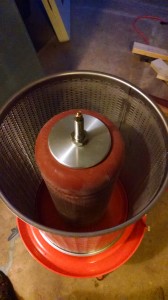
Inside the bladder press – the bladder at the center fills with water and expands to gently squeeze the grapes.
Well, not quite. It turns out the crushed grapes fall through the entire length of the bottom of the crusher, and need to be funneled into some kind of container, either a small fermenter or buckets to carry the grapes to a larger fermenter. So, I turned back to MoreWinemaking, which is where I bought the crusher to see about a stand. It cost $325, which isn’t terrible, but it would have cost nearly as much to ship it, since it has to go by truck. That just seemed wrong, somehow. I had paid one shipping cost for both the crusher and bladder press, and while the shipping was expensive, it was still only a fraction of the cost of the two pieces of equipment. In the case of the stand, I just couldn’t bring myself to pay as much for shipping as for the item itself.
So, I tried other vendors, and the story was the same everywhere, until I stumbled across Carolina Wine Supply. They were willing to ship it UPS or FedEx, unassembled in a flat box, for something like $25. Definitely a company I’ll be doing more business with.
For what it’s worth, having equipment shipped by truck isn’t exactly a trouble-free process. They really want to ship to businesses with loading docks, not to suburban homes, and the cost goes up significantly for the latter. Moreover, they expect you to make arrangements to be there when they arrive, which can be difficult because they don’t always provide much advance warning. I was able to bargain with the trucking company to leave the items on my driveway while I wasn’t home, which worked after a couple of false starts, but it did mean I waived my rights to inspect the items for damage. Well, you work with what you got.
At some point over the summer, I began to wonder where I would store the wine while it was fermenting and aging. Once the initial fermentation is complete, the wine goes into glass carboys for secondary fermentation and, later, for aging. I have quite a number of glass carboys, and it occurred to me that spreading them across the garage wasn’t practical.
A six gallon glass carboy is heavy to begin with, but once full, it weighs an additional 48 pounds, so moving a full carboy around is physically demanding and mentally harrowing. If it slips from your hands and breaks, you end up with a garage full of spilled wine and broken glass. Not good.
So, I’m constructing a garage “barrel room” that should be large enough to hold 15 six galloncarboys on three shelves, plus either large plastic fermenters, small oak barrels or more carboys on the floor. The shelves are installed at a 15 degree angle, which makes it easier to insert a wine thief or racking cane into the back shelf. By using a pump to move wine, I’ll never have to lift a full carboy.
The very top shelf will hold an assortment of one gallon jugs, supplies etc., and a 5,000 BTU air conditioner mounted near the top will keep it cool inside. I have most of the inside finished, but need to build the doors and mount the air conditioner.
I’m pretty pleased with the way this home “barrel room,” looks, and I have to credit Steve Hughes’ book,The Homebuilt Winery. The book includes the plans, but fair warning, the average person will probably want to spend some time studying and interpreting the plans. I’ve done a lot of home construction projects in my time, and I have a pretty complete workshop, but I still found some parts of these plant to be a chore to figure out. So, while I like the book a lot, I wish it had provided a bit more detail for some of the projects.
However, the idea for the barrel room was worth the cost of the book, and the plans were adequate to get me through the project. The book also gave me the inspiration to build a dolly to move the crusher-destemmer around, and there are a few other projects that I might eventually take on. For the really ambitious, he shows you how to build your own ratchet press and destemmer, and a dozen or so other things. All in all, it’s a book I’d recommend for the aspiring Garagista.
We’re hoping to harvest Viognier in just a few days, though with rain in sight, that may not happen. Hopefully the grapes have another week in them before they start to become over-ripe. I was thinking of picking last week, but the brix (sugar level) was at 21, a few points lower than I wanted. The decision on when to harvest is based on lots of things, including ripenesss and the weather forecast, and you don’t always get the perfect combination. Waiting can be stressful, and it was hard to resist picking those Viognier grapes last week. A friend at a nearby winery counseled me to wait and deal with the stress, adding, “don’t lose your nerve!”
Well, I haven’t. At least not yet!
A Holiday Book List for Wine Lovers
With the holiday season upon us, I can’t think of a better gift for someone you love (or even someone you don’t like all that much, but for some reason are obligated to buy a gift for) , than a book about wine, save perhaps for a bottle of the actual stuff. In the time since I started writing this blog, I’ve read a fair number of books on this subject, many of them about the process of growing grapes and turning them into wine, others on the joys of drinking wine, and still others on some topical issue, such as the touchy subject of natural wine.
With that in mind, I thought I’d list a few books that might make a nice gift for a friend or stocking-stuffer (yes, I know, that would be some big stocking – but you can just leave it under the tree). Most of these are books I’ve read and enjoyed, and some are volumes that I’ve put on my own list. Among those in the category of books I’ve loved, I’ve either reviewed them or have plans (and yes, I have more plans than time) to write a review on Project Sunlight. So, stay tuned. Meanwhile, here’s the list:
Some Books I’ve Loved
Of all the books I’ve read about wine, I’ve enjoyed none more than Authentic Wine by Jamie Goode and Sam Harrop MW (Master of Wine). 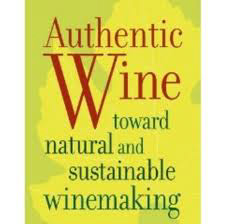 The book’s subtitle, Toward Natural and Sustainable Winemaking, gives a broad hint about where it’s heading, but one of the most appealing things about the book is its balance. The authors clearly respect the idea of natural wine and sustainable viticultural practices, but their first priority appears to be good wine, and they understand that a business isn’t sustainable if it isn’t profitable. Authentic Wine falls neatly into two parts, one dealing with viticulture and the second focusing on winemaking. I’ve read this book twice (you’d think after that I’d have taken the time to write at least a short review), and I’ll will probably read it yet one more time. They write intelligently and lucidly about a variety of current issues in the wine world, from reduction to the difference between natural and cultured yeasts to the trend toward riper fruit and higher alcohol levels. The get into the science and technical issues, but the writing is accessible and easy to follow. That’s quite a rare feat, and one of the reasons I’m so high on Jamie Goode.
The book’s subtitle, Toward Natural and Sustainable Winemaking, gives a broad hint about where it’s heading, but one of the most appealing things about the book is its balance. The authors clearly respect the idea of natural wine and sustainable viticultural practices, but their first priority appears to be good wine, and they understand that a business isn’t sustainable if it isn’t profitable. Authentic Wine falls neatly into two parts, one dealing with viticulture and the second focusing on winemaking. I’ve read this book twice (you’d think after that I’d have taken the time to write at least a short review), and I’ll will probably read it yet one more time. They write intelligently and lucidly about a variety of current issues in the wine world, from reduction to the difference between natural and cultured yeasts to the trend toward riper fruit and higher alcohol levels. The get into the science and technical issues, but the writing is accessible and easy to follow. That’s quite a rare feat, and one of the reasons I’m so high on Jamie Goode.
Also high on my list is Mike Veseth’s wonderful discussion of current wine industry trends, Wine Wars. (Reviewed March 28, 2013) Subtitled, “The Curse of the Blue Nun, the  Miracle of Two-Buck Chuck, and the Revenge of the Terrorists,” this book ranges over a great deal of history to put some of the trends into context, and provides a lot of insight into some of the things, like Trader Joe’s and Costco, that are right in front of our eyes. Could a two-dollar (somewhat more outside of California) bottle of wine have succeeded if it had been sold anywhere else but at Trader Joe’s? In a world in which quality is often equated to price, it might not have worked at a retailer that had not already won the trust of its customers. And yet, in Europe, some perfectly drinkable wines sell (or at least sold recently) for a Euro a liter, making it effectively One-Buck Chuck. Mr. Veseth writes with the authority of the wine economist (a profession I did not know existed prior to reading this book), he is, and it’s clear that he not only knows a lot about wine, but that he loves it as well. The fact that his prose is both clear and engaging is just a bonus. Continue Reading–>
Miracle of Two-Buck Chuck, and the Revenge of the Terrorists,” this book ranges over a great deal of history to put some of the trends into context, and provides a lot of insight into some of the things, like Trader Joe’s and Costco, that are right in front of our eyes. Could a two-dollar (somewhat more outside of California) bottle of wine have succeeded if it had been sold anywhere else but at Trader Joe’s? In a world in which quality is often equated to price, it might not have worked at a retailer that had not already won the trust of its customers. And yet, in Europe, some perfectly drinkable wines sell (or at least sold recently) for a Euro a liter, making it effectively One-Buck Chuck. Mr. Veseth writes with the authority of the wine economist (a profession I did not know existed prior to reading this book), he is, and it’s clear that he not only knows a lot about wine, but that he loves it as well. The fact that his prose is both clear and engaging is just a bonus. Continue Reading–>
Vineyard Diseases and How to Cure Them
It’s scary to think about how many predators are out there waiting to attack the average vineyard. Birds, bees, foxes, rabbits, deer – Even Bambi can’t be trusted! – and a host of insects, from the potato leafhopper to the Japanese Beetle, want nothing more than to devour the vines, from their leaves on down to the grapes themselves. And that isn’t counting the fungi.
Last weekend at Monticello, Gabriele Rausse taught a class on vineyard diseases that was as wonderful (Gabriele and Monticello) as it was depressing (birds, bees, deer – you get it). The predatory Bambis of the world can be controlled fairly easily with fences. Birds, which begin taking a serious look at the vines after the sugar level rises almost to the point where it is time to harvest, can be scared away with foil streamers that are hung at intervals so that they fly in the breeze.
But fungi are a different story. They require lots of attention, and no small amount of chemicals. Unlike California’s wine valleys, where vines grow in dry heat with cool nights and little rain, Virginia vineyards are subject to heat, humidity and lots of rain. (Especially this year.) All of which provides a good, but hopefully not perfect, environment for a variety of fungal diseases to take root, so to speak. Black Rot, Downy Mildew, Powdery Mildew, Botrytis (and not the good kind of Botrytis, the “noble rot” responsible for Sauternes) and many other diseases just lie in wait for the conditions that enable them to ruin a vineyard.
So, that means spraying. Not just once or twice, but routinely, weekly and especially after three-quarters of an inch or more of rain. We’d love to go organic and dispense with the spraying, but it’s not possible in Virginia, at least not with vines. I don’t know if other fruits and vegetables can be grown in Virginia without spraying, but I’m inclined to think you can’t. Certainly, Virginia Tech’s Cooperative Extension service web site has tons of information about spraying programs for fruit and vegetables, which implies that fungicides are needed. But whatever the case for other types of fruit, wine grapevines require spraying.
That’s also true in other environs. Gabriele said they had to spray in his native Italy (the Veneto region), for example. So, it’s not a crime to spray. But it does make for a lot of work and expense, one of the reasons, in fact, that Virginia wine is so expensive.
And by the way, if you're interested in this subject, the best source of information availale, at least for Virginia viticulturists — and probably for grape farmers everywhere — is Mizuho Nita's blog. It's a must-read for anyone interested in growing wine grapes in Virginia.
Spraying is a discipline, and it's one of those things you have to do when it's needed, whenever it's needed, with no exceptions. Hard work, for sure. But I think it's worth it, and that the end result of all that pest management will be wine that is truly memorable.

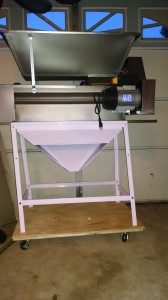
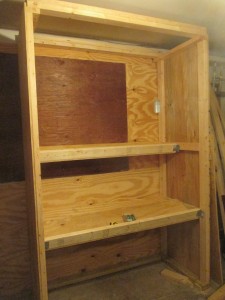
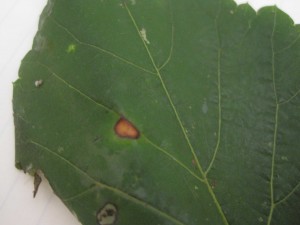
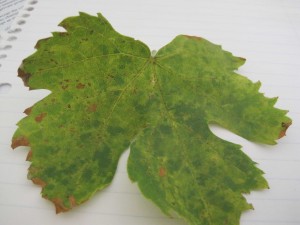


Recent Comments